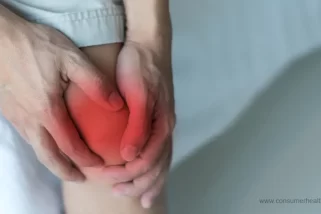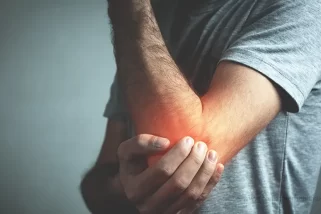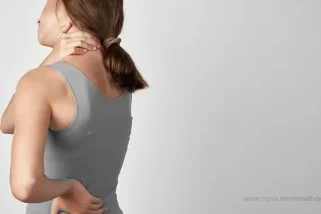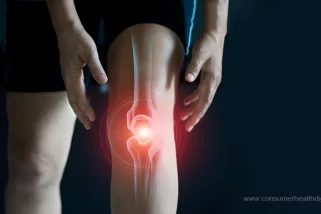What is Osteoarthritis?
Osteoarthritis is a disease in which the joints of your body are affected. It is a form of arthritis and is characterized by swelling and pain in the joints. It also influences the motion of your joints.

What Causes Osteoarthritis?
Bones are made of protective cartilage. Cartilage is a tissue that is coated at the ends of the bones. The cartilage breaks down over a period of time. Healthy cartilage is supposed to absorb the shock that is created during any sort of movement. Due to the wear and tear of the cartilage, the bones are left with no protective layer and end up rubbing against each other. Constant rubbing of the bones against each other over a long period of time can permanently destroy the joint. Osteoarthritis is likely to affect people who are:
- Older
- Overweigh
- Have a joint injury
Osteoarthritis Signs and Symptoms
The symptoms of osteoarthritis develop very slowly but get worse with time. Some of the signs and symptoms are:
- Stiffness: Stiffness in the joints can be experienced, especially after getting up from sleep.
- Pain: The affected joint of your body may hurt while or after using it.
- Loss of flexibility: You may lose the flexibility of the affected joint.
- Tenderness: You may get a feeling of tenderness in your joints when you apply force to them.
- Bone spurs: You may feel lumps around the joint.
- Grating sensation: While using the joint, you may experience a grating sensation.
However, you can get relief from these symptoms with the use of joint pain supplements.
Read Voltaren Gel Review to explore how it helps to treat joint pain.
What are the Effects of Osteoarthritis?
People suffering from osteoarthritis experience pain in their joints along with stiffness. It does not affect everyone in the same way. Many people feel it is developing over a significant period of time, while others may find it is progressing rapidly. Some people may find it mild, while others may find it difficult to do even their daily tasks. Some joints that are commonly affected by this disease are:
- Hips
- Lower back
- Knees
- Neck
- Thumbs
How Osteoarthritis is Diagnosed?
The doctor is likely to examine the affected joint to look for stiffness, swelling, or tenderness. He may also ask you to get some tests done. The imaging tests include X-ray tests and magnetic resonance imaging.
X-rays help in the diagnosis of osteoarthritis by showing the wearing out of the cartilage in the form of a narrow space between the bones. The magnetic resonance imaging test makes use of radio waves and magnetic fields to generate images of the bone.[1]
This test is beneficial in analyzing the exact cause of pain. Apart from these, lab tests like blood tests and joint fluid analysis also help in diagnosing osteoarthritis.
How to Manage and Treat Osteoarthritis?
Apart from medications, therapies, and surgeries, a positive attitude and a healthy lifestyle are very important to manage and treat the disease. This includes eating and sleeping well, following a regular exercise regime, and staying active.
Most importantly, it is essential that a person suffering from osteoarthritis have a positive attitude. An optimistic outlook gives you the ability to manage and handle the disease better.
Alternative medicine that has proved beneficial for treating and managing osteoarthritis includes acupuncture, yoga, and tai chi. You can also consider using joint pain products such as Curafen to quickly get rid of joint pain.
Expert’s Opinion
The National Institute of Arthritis and Musculoskeletal and Skin Diseases conducts research to better understand the disease and its related areas. The researchers at the institute are trying to develop a new method to monitor and detect changes in cartilage. This method will help the doctors treat the disease even before it is detected in the X-rays.[2]
Osteoarthritis treatments to relieve pain
Osteoarthritis doesn’t have a cure, and it can get worse. But there are treatments that can help make the symptoms feel better.
Medications
Over-the-counter medications like acetaminophen and NSAIDs work by reducing pain and inflammation. Acetaminophen helps relieve pain but does not reduce inflammation. NSAIDs like ibuprofen or naproxen work by reducing both pain and inflammation. Prescription medications may include stronger NSAIDs or other pain relievers and can be more effective for severe osteoarthritis pain.
Physical therapy
Research suggests exercise can help strengthen muscles that support the joints. This takes stress off the joints and improves mobility. Therapists may recommend low-impact activities like swimming or biking. Range-of-motion and stretching exercises keep joints flexible. Strengthening exercises for muscles around the knees, hips, and other joints is also important.[3]
Braces and supports
Knee braces provide compression and support to take pressure off the knee joint. Ankle braces stabilize the ankle joint to make walking easier. Shoe inserts or orthotics provide arch support and can correct foot alignment issues that cause extra stress on joints.
Weight loss
Extra weight places more stress on weight-bearing joints like knees and hips. Even losing 5-10% of total body weight can help reduce pain for people who are overweight or obese. As per a research, exercise and weight control are the best treatments for Osteoarthritis. If needed, topical NSAIDs, oral NSAIDs or injections can be used.[4]
Heat/cold therapy
Applying a warm compress or ice pack for 15-20 minutes a few times a day can temporarily relieve stiffness and pain. Heat increases blood flow to bring in more nutrients and relax muscles and joints. Ice reduces swelling and numbs pain receptors.
Surgeries for Osteoarthritis
Arthroscopic surgery
This is a minimally invasive surgery where a tiny camera and surgical instruments are inserted into the knee joint through small incisions. The surgeon can then remove loose fragments of cartilage or bone and smooth rough areas inside the joint. This aims to relieve pain.
Osteotomy
This surgery involves cutting and reshaping the bone below the kneecap or thigh bone to redistribute weight forces across the joint more evenly. This can help reduce pain from osteoarthritis in the knee.
Joint replacement (arthroplasty)
For severe osteoarthritis, when other treatments no longer help, the damaged joint surfaces may be replaced through total knee replacement or total hip replacement surgery. The surgeon removes the damaged bone and cartilage and replaces them with artificial implants. This can significantly reduce pain and improve mobility.[5]
Meniscus repair/replacement
For a torn meniscus in the knee, the surgeon may repair or partially remove the damaged part of the meniscus. In some cases, a damaged meniscus is completely replaced with an artificial one.
Ligament reconstruction
This surgery is done for osteoarthritis caused by ligament damage in the knee. The surgeon repairs or replaces the damaged ligaments.
Conclusion
Osteoarthritis is a common condition that causes pain and stiffness in the joints. While there is no cure for OA, lifestyle changes and treatments can help manage symptoms and improve quality of life. Getting regular exercise can help strengthen muscles around joints and reduce pressure.
Maintaining a healthy weight takes pressure off weight-bearing joints like knees and hips. Over-the-counter pain relievers can help with mild to moderate pain. People can also use bone supplements to relieve the pain.
For those with more severe symptoms, joint injections or prescription medications may provide relief. In some cases, joint replacement surgery can resolve pain and restore mobility for people with advanced osteoarthritis. With treatment and self-care, many people can successfully manage their osteoarthritis.
5 Sources
We review published medical research in respected scientific journals to arrive at our conclusions about a product or health topic. This ensures the highest standard of scientific accuracy.
[2] Expert’s Opinion: https://www.niams.nih.gov/
[3] Effects of exercise on knee osteoarthritis: https://pubmed.ncbi.nlm.nih.gov/33666347/
[4] Non-surgical management of knee osteoarthritis: https://pubmed.ncbi.nlm.nih.gov/33116279/
[5] Total Hip Replacement: https://orthoinfo.aaos.org/en/treatment/total-hip-replacement/








 This article changed my life!
This article changed my life! This article was informative.
This article was informative. I have a medical question.
I have a medical question.
 This article contains incorrect information.
This article contains incorrect information. This article doesn’t have the information I’m looking for.
This article doesn’t have the information I’m looking for.